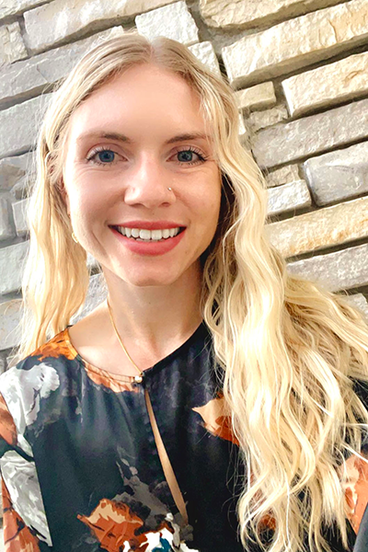July 29, 2022
Ally Taubenheim, DNP, APRN, CPNP, believes in interprofessional education (IPE).

“It sounds simple, but I have learned that one of the greatest challenges to making IPE a reality is inviting people to dream bigger and envision health care differently to improve the health and wellbeing of patients, communities, staff and learners,” she said. “IPE is key to improving patient care delivery models and population health outcomes, and is an avenue to advance equity among team members and patients.”
When she learned of the opportunity to become part of the inaugural cohort of students in the Interprofessional Internship Program in 2020, she jumped at the opportunity.
“It takes practice to be an IPE leader. This internship was a great opportunity to learn and lead with other interns to solve problems for clinical partners, and advance interprofessional education and practice,” she said.
Working with a clinical partner on a problem-based project
In the first year of her internship, Taubenheim and two of her fellow interns worked with the Community-University Health Care Center (CUHCC), which had recently transitioned to a new intranet site for all staff and learners that created opportunities for innovative updates to a variety of programs at CUHCC, which was an identified area of need post COVID-19.
“The new content is meant to serve both learners and staff,” said Taubenheim. “In the beginning we learned that the improved experience for learners is two fold: how learners integrate on an integrated team with CUHCC staff, and how an interprofessional team integrates a learner. One of the first identified areas for improvement was the learners’ interprofessional experience at CUHCC, which evolved into a clinic-wide initiative focused on improving quality and compliance program design. Revamping the Quality page opened an opportunity to improve the learning experience not just for learners but all staff. This program identifies the learner’s value-add to CUHCC as an organization as well as cultivating an optimal educational experience for all staff.”
As a second-year Interprofessional Intern in 2021-22, Taubenheim and her internship colleagues continued working with CUHCC to understand its current Patient Satisfaction Survey requirements and map annual workflows.
“Specifically, our goal was to develop a project that was sustainable and replicable for the following years,” she said. “Our task was to plan and trend quantitative and qualitative data at varying levels. We codified and mapped templates that will be used for inputting future Patient Satisfaction Survey results to help support the clinic's quality assurance and improvement efforts. Our main goal was to develop and disseminate a project that was sustainable and replicable for yearly data trending as well as templates for other community health centers and health care organizations that engage with midwest clinicians.”
Taubenheim says the Interprofessional Internship gave her real world experience on how to solve big problems in health care and function at a systems level to improve quality outcomes.
“This translation piece from academia to the clinical setting was essential for me upon graduation to prepare me for my career. But most importantly, it showed me the power of working in an interprofessional learner team,” she said. “As a learner and an Interprofessional Intern, I was elevated within the organization to improve strategic goals and initiatives for the clinic and transform interprofessional education and collaborative practice. This was a unique experience because I was elevated in my role as learner, which was something I had not experienced elsewhere.”
From intern to practitioner
After graduating from the School of Nursing’s Doctor of Nursing Practice program this past spring, Taubenheim joined the CUHCC team as a pediatric nurse practitioner and was given the opportunity to be its lead interprofessional education specialist.
“CUHCC leads in team-based care and is committed to advancing health equity through collaboration with each other,” she said. “Within this role, I will lead the strategic goals for IPE and foster team-based care for all staff, learners and patients.”
Taubenheim works closely with CUHCC’s quality team and education team to further interprofessional education among all departments. Additionally, she oversees the integrated care teams at CUHCC, a formal team design that was launched for all staff two years ago.
“I am excited about this new role and I am inspired daily by my colleagues who lead in team-based care for the communities we serve,” she said.
Why health sciences students should pursue the Interprofessional Internship
Taubenheim enthusiastically recommends the Interprofessional Internship program to all health science students.
“Becoming a leader in IPE has named the trajectory for who I am as a health care professional, to challenge the status quo and change the way I lead, think, act and behave,” she said. “As an Interprofessional Intern, you will have the opportunity to situate yourself among a brilliant group of people and learn with, from and about each other to advance health care for all people in Minnesota.”
Offered by the Center for Interprofessional Health with support from the Office of Academic Clinical Affairs, the Interprofessional Internship Program enables students to learn and lead together, solve problems for clinical partners, develop real-world working relationships, and advance interprofessional education and practice. The next intern application cycle will open August 2022.